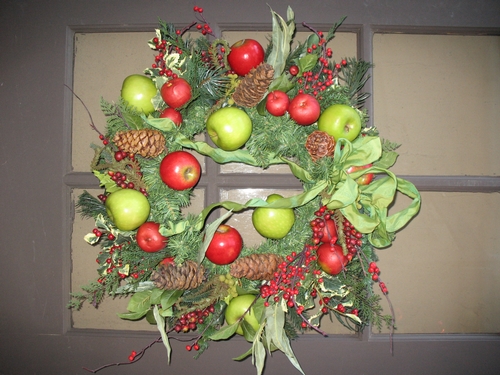UC Blogs
Make Your Own Holiday Decorations
Wreaths, garlands, valance hangings and table decorations, graced with velvet ribbons and fruits and leaves of the season, are easy-to-make glories during the holiday season.
Like giving certain flowers to imply messages (love with a white rose or remembrance with forget-me-nots), you can decorate your wreath or hanging with items that are especially meaningful to you. If you're giving it to a friend, include items of special significance to the two of you to make it all the more a treasure. It can commemorate a special day or event, or it can just celebrate your camaraderie.
In ancient Rome, circular wreaths were symbols of victory and celebration. In 16th century Germany, fir or spruce wreaths were laid flat on a table with a candle lit on the first Sunday of Advent. Today, the wreath symbolizes continuity and tradition.
Evergreen boughs brought indoors by Druids were honored as sacred plants that didn't die, allowing the house to survive the winter. Primitive tribes in Europe hung evergreens above their doors during the winter solstice to offer woodland spirits shelter. They hoped that this would bring good fortune and health. Today's garlands continue to brighten our door and window sills, mantels and tables.
Your creation can be as simple as a bunch of your favorite herb branches tied with a ribbon, or as complex as a large and intricate wreath embellished with many sentimental items from a person's lifetime. It can be fancy or plain and worked on for weeks or completed on the spur of the moment. It all depends on what you want and what materials you have collected.
Materials can encompass anything you have access to, such as grapevine trimmings off the back fence and herb sprigs from the kitchen garden to pine cones from an excursion in the foothills. A great way to find unexpected goodies is to wander the aisles in a craft store, trying different combinations of textures and colors and seeing what strikes your fancy. Matching ribbons and other bits and pieces to friends' personalities is always great fun.
Looking at "ordinary" items in a new way can also reveal many possibilities. Green and red bell peppers add holiday cheer to a wreath on the front door. An oddly curled Armenian cucumber or long-necked squash becomes decoration in a table arrangement. A tree ornament becomes special when it's the only one on a wreath hung on child's door. Anything and everything becomes fair game for decorating. It's all up to your cleverness and sense of humor.
Materials to consider for the wreath or garland base
- A whole sunflower head with the central stem portion removed, forming a "donut"
- Dried sphagnum moss (the long stringy kind, not milled)
- Eucalyptus foliage
- Evergreen clippings (pine, spruce, holly, redwood, cedar, osmanthus and juniper)
- Forsythia branches (young)
- Grapevines
- Hay
- Herb foliage (bay laurel, coriander, sage, marjoram, oregano, rosemary, basil, lavender and pennyroyal)
- Honeysuckle trimmings
- Magnolia leaves
- Olive branches (young)
- Pinecones
- Raffia
- Straw
- Styrofoam flat shapes or balls
- Willow branches (young, peeled to reveal blond-colored wood)
- Wisteria trimmings
Materials to consider for decorations
- Candy canes
- Chili peppers
- Cookies (cutouts and gingerbread men)
- Dried ferns and other greens
- Dried flowers
- Dried fruits
- Dried Indian corn ears with husks partially removed to reveal colored kernels
- Dried rosebuds splashed with rose oil
- Dried safflower pods
- Eucalyptus pods
- Fabrics in rich colors, patterns and textures
- Fall-colored leaves
- Florescent glow strips and stickers
- Fresh flowers
- Fresh fruits
- Garlic heads
- Herb blossoms and berries
- Magnolia seed cones
- Miniature tree lights
- Mistletoe
- Nuts (walnuts, almonds, filberts, brazils and chestnuts)
- Onion bulbs
- Oranges stuck with whole cloves
- Ornaments
- Pinecones
- Popcorn on a string
- Pretzels
- Pyracantha clippings of berries and leaves
- Raffia
- Ribbon candy
- Seed pods
- Shocks of wheat or sorghum
- Silk flowers
- Small statuary
- Tinsel
- Your child's artwork
Another Day, Another Ton of Weeds
Here I am, writing when I could be outside either flying the dog or ripping out more weeds from the “dry” creek. That darn “dry” creek has more water in it just now since the rain yesterday than the dog’s water bowl. I wasn’t really kidding about flying the dog as LuLu weighs just over 9 pounds and has very large ears and there is a very stiff wind blowing. Bruce and I joke around that at a time like this, hitch LuLu to her leash and let her soar instead of walk to the nearby park.
Earlier this week, we got down and dirty with the chemicals in the war against Bermudagrass, various other grass varieties, and my old “buddy” – oyster salsify! Using the IPM system, we have managed to NOT hold our own against these “arch fiends” of the home and garden.
Nope, not a napalm strike exactly, but the judicious use of herbicides and pre-emergents to keep from mowing in the house itself.
Pre-emergents are very useful tools in order to contain weed seeds when used at the proper time. Use in October for the spring weed seeds and again in February for the fall and winter weed seeds. It’s very simple and quite easy. I missed out in October because there was no rain; with the product I use, I need at least ½ inch of water. With Bruce, no rain = no spray; it’s not that he’s not a believer, but water = $$$ which he is loathe to spend. With rain, he’s raring to go, so it got done!
The grass spraying is a more delicate proposition. Using an all-purpose herbicide means death to any plant getting hit. So the game plan is: select the target, find an herbicide for that particular target group and read, READ the label. Select the appropriate product and use according to the directions to the letter!
So far, the spraying of the grassy weeds in the rose beds, the backyard potion of the dry creek, and the other areas of the back and side yards has been completed. I’m holding my breath that the guaranteed shades of red and/or brown will appear showing the weed plants are on the way out and make the other grassy weeds quake on their roots.
The last few years have been the years of grassy weeds. When we first started out here, there was nothing but tumbleweeds growing in the back forty. It only took 2 years to get rid of them but now, in a way, I wish those tumbleweeds, Russian thistle (Salsola iberica) were still here. I don’t know if you’ve read in the little magazines from the newspapers that some towns have festivals with prizes for the best use of the things and the having the biggest! Wow, my crops would have taken 1st prizes and built mansions! Alas, this information has come years too late!
Next were the years of the bristly oxtongue (Picris echioides). That stuff grows everywhere, and if you get dermatitis from it as I do – it got left alone as Bruce doesn’t do “prickle bushes” and I worked well out of town. Then came dandelions and finally the oyster salsify and the Bermudagrass. Unfortunately, for this group of weeds, I’m retired now and have all the time in world – my back allowing – for pulling up and hoeing the little darlings! The beautiful thing these days is now I’m the supervisor now at home and I’ve given myself a long lunch, starting now. See ya!!
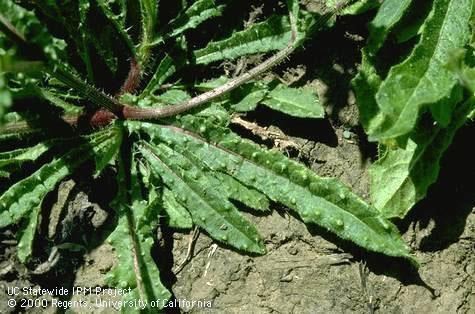
Bristly oxtongue. (photo by Jack Kelly Clark)
Linking Art with Science
So, you want to know more about butterflies and art, and the link between art and science. You’re in luck. Butterfly expert Art Shapiro,...
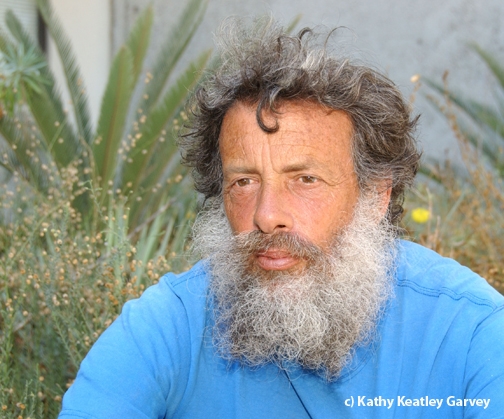
Butterfly expert Art Shapiro of UC Davis. (Photo by Kathy Keatley Garvey)
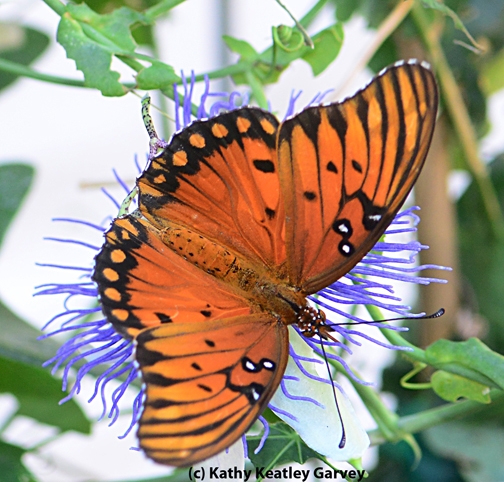
Gulf Fritillary butterfly on passion flower blossom. (Photo by Kathy Keatley Garvey)
Thankful for Insects
Of the many things I'm thankful for on this Thanksgiving Day, I am thankful for the millions of insects that populate our planet. Scientists have...
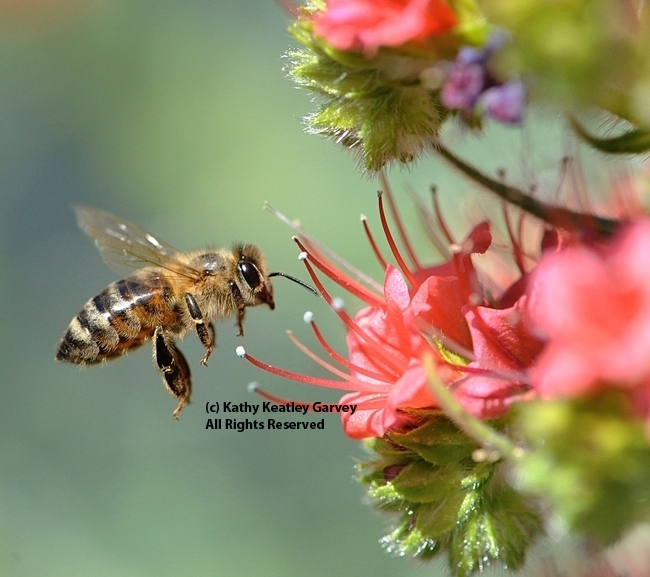
A honey bee heading for a tower of jewels, Echium wildpretii. (Photo by Kathy Keatley Garvey)
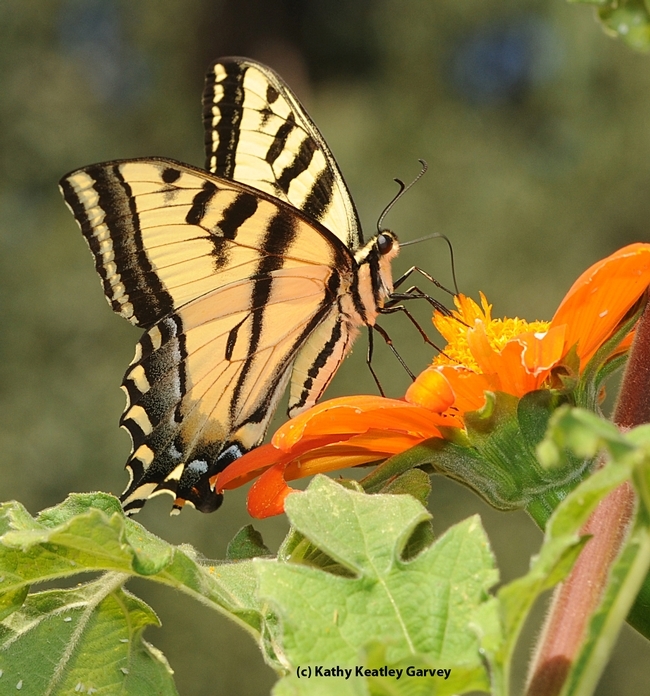
A Western tiger swallowtail on a Mexican sunflower. (Photo by Kathy Keatley Garvey)
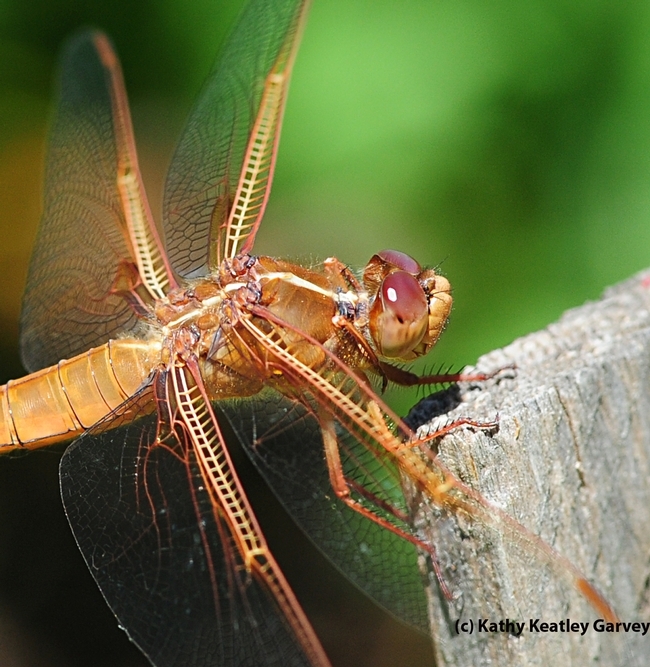
A flame skimmer dragonfly at rest. (Photo by Kathy Keatley Garvey)
Gardeners Greenhouse
Recently, a friend of my husbands asked if we would like to come to his home to see the greenhouse he, his son and wife had built in their backyard. He went on to tell us how successful his summer garden had been and where he had donated his excess produce. On a weekly basis, he took bags of produce to Opportunity House and the Episcopal Church in Vacaville plus Mission Solano in Fairfield.
Needless to say, I was curious about his successful venture, especially when he told us this success was his motivation to build the greenhouse. He wanted to grow and provide vegetables all year, not just in the summer. The vegetables he had grown were peppers, tomatoes, onions, lettuce, carrots, plus herbs, raspberries, blackberries and blue berries.
The greenhouse is 8.5 feet by 12 feet. The entrance height is 7 feet while the peak inside is 8 feet high. The welded framework is made of 2 inch steel tubing (like horse corrals and ranch gates). The four corner anchor posts are cemented and the rest of the greenhouse is clamped to these posts. This allows it to stand straight on uneven ground. There are two ends with nylon screen “windows” and a window in the rear. Over the entire framework is ‘Green.tek’, a plastic sheeting obtained online that was designed for greenhouses. This plastic can be rolled up over the 3 windows to allow air circulation.
It took 3 weeks and several weekends to construct the greenhouse. An electrician added electricity and a water line was brought into the interior. The ‘floor’ is a thick layer of bark. Raised beds (1 ½ feet high) were built. River rock was placed in the bottom of the raised beds, with layers of leaves, potting soil and topsoil added.
This project was so gratifying, his son has decided to go into the greenhouse building business. Being a mechanical engineer he has the knowledge to succeed. Meanwhile, his dad is eager to share his produce with those in need.
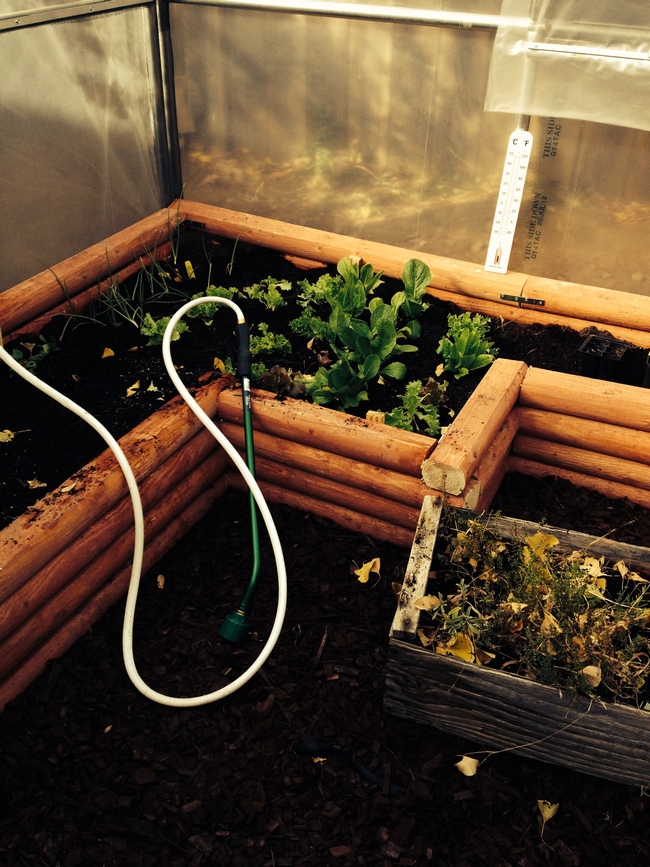
Garden bed.(photos by Sharon Rico)
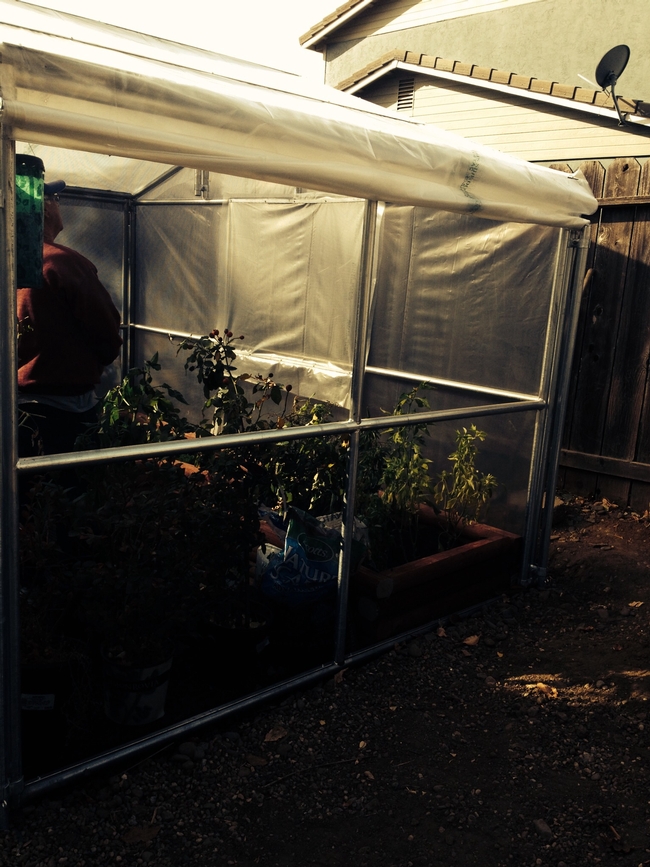
image
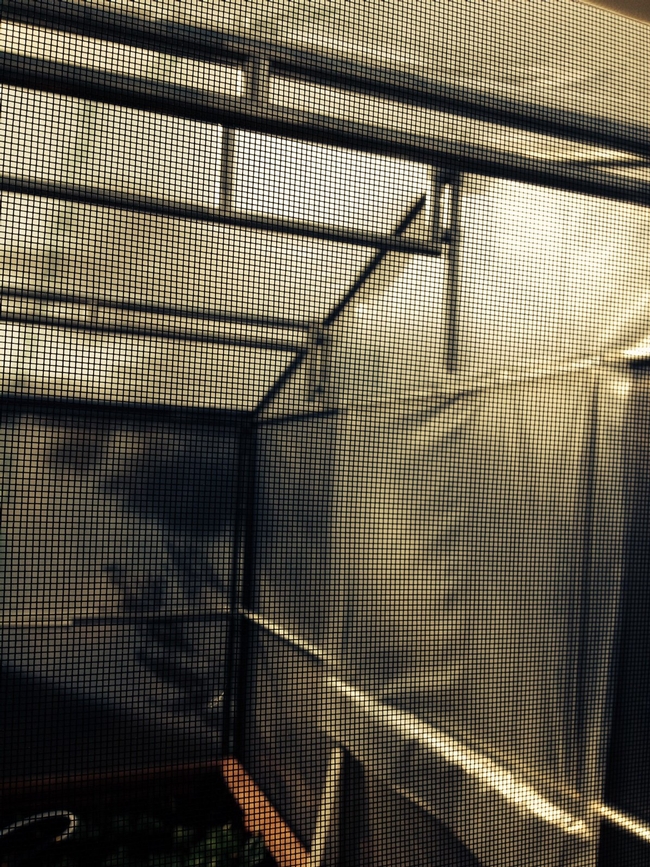
image


